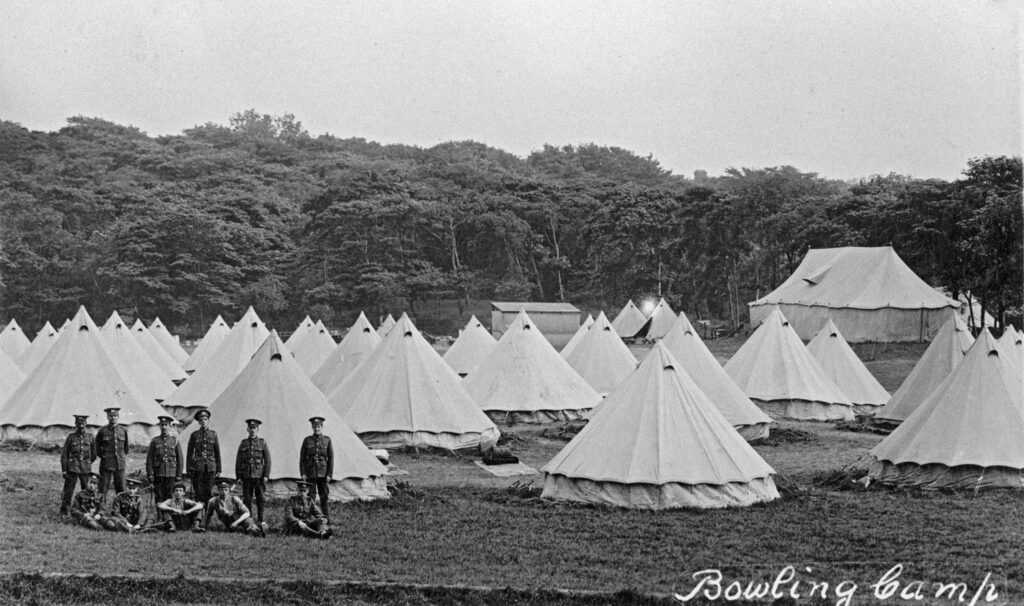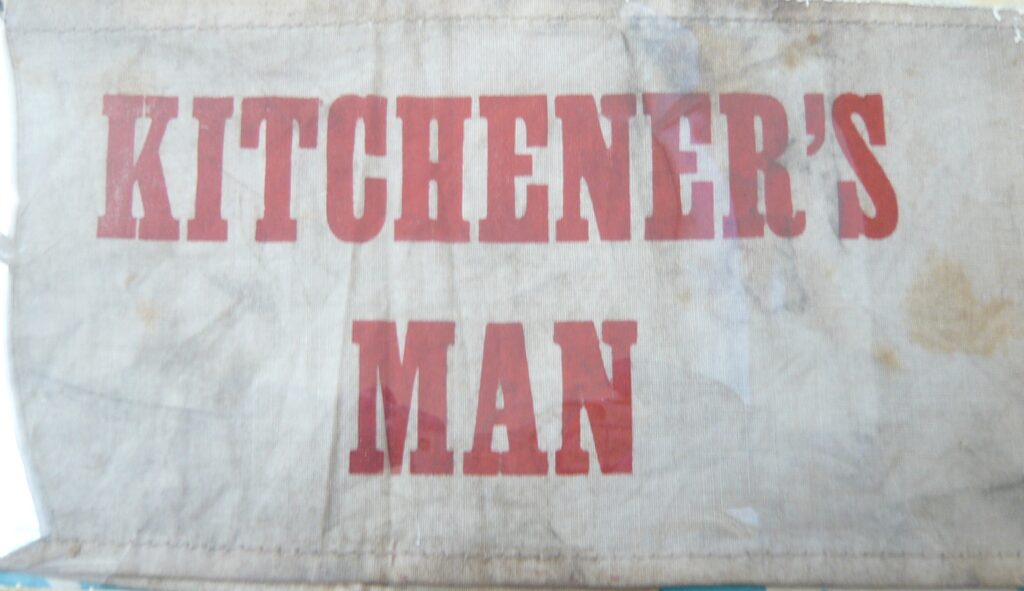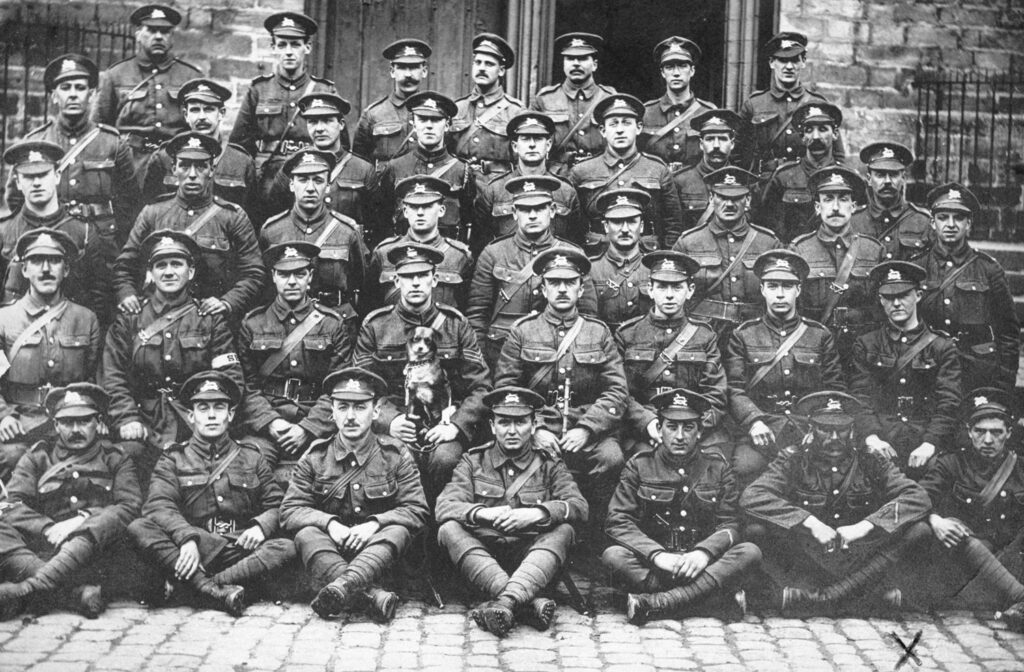Liz McIvor, our Curator for Social History and Technology has written this timely post for us (given that Remembrance day takes place this month) about the Bradford Pals and their temporary barracks at Bowling Park during World War I.
She writes:

Before 1914 the army had had a pretty bad press and a sight like this at a local park would have been very concerning to the locals. Although an army commission was a suitable post for a younger son of a wealthy man, the rank and file were usually those with few employment options and very many were convicts. Being part of the standing army was an itinerant lifestyle, poorly paid and with few prospects. It wasn’t always possible to accommodate familieand discipline outside barracks was poor.
Signing up for the ‘kings shilling’ was usually a last resort, especially for those who wanted to disappear. Before the 1914 DORA (or Defence Of the Realm Act) which required citizens to carry identity cards it was relatively easy for a person to assume a name and join the army.
After 200 years of less than savoury reputations in recruiting and discipline, most citizens viewed soldiers with suspicion and even hostility. Pubs commonly carried signs saying ‘no soldiers’ on the door and avoided serving military men in uniform or large groups to avoid disturbances.
The standing army and volunteer soldiers had also been traditionally used to put down strikes and riots and had done so in Bradford in the years just before the war. These heavy handed tactics were used in manufacturing towns in both Yorkshire and Lancashire, and the army’s popularity before the war, was as a result, at an all time low.
Times in Bradford before 1914 were hard, as slumps in the textile trades had laid many workers off and wages were kept low. Strikes had been unsuccessful, and the most likely people to be out of work were those who were mature adults (with families to support) who were also the most expensive to employ.
The intrusion of the state through use of the forces was as antagonistic to the unemployed and strikers as the use of the police would be in the later 20th century with the miner’s strikes of the mid 1980’s.
So why did this change? Because by the second year of the war, recruitment based on sentimental and patriotic fervour meant that everyone knew someone in khaki and these were the respectable boys or the ordinary ‘Tommy’.

Initially, the optimistic feel of the war encouraged some to join up, and the promise of a steady wage also appealed. One young recruit in an apprenticeship at the time, Earnest Wilson, earned a low wage and having been rejected in 1914 went to ‘join up’ the following year. He weighed less than eight stone at the recruiting office for the ‘2nd Bradford Pals’ in 1915, but was accepted anyway because recruitment rules on height and weight had been relaxed in order to swell the ranks of a new 18th battalion of the West Yorkshire Regiment, who were desperately needed in France.
The first ‘Pals’ left for training camps in January of 1915, and the new recruits would also have to be given basic training and organised to move to the front too. A camp for these recruits was set up at Bowling Park, and recruiting was also carried out across the district, both north and south in the townships of Keighley and Cleckheaton to mop up anyone left out in the previous year who had been too young, or not passed the medical examination.
The recruits were to move to a temporary village at Ripon to train eventually, but were first put up in a sea of canvas at Bowling Park so that they could begin to live and behave as a unit.
Relatively few images survive (the one at the top of the blog is one of the few) but the camp would have been visible from the nearby Bolling Hall, where preparations were underway for its grand opening in September 1915.
The park was a thoroughfare for local people, who continued to use it in their leisure time and as a cut through to Manchester Road. The camp itself was close to the ornamental gardens backing onto the area now known as Springfields and Parkside.
During the Pal’s time at the camp, they performed a number of marches and parades, and trained for long marches ahead.
Conditions in the camp were crowded and sanitary facilities limited, but men were encourage to eat and sleep in close and uncomfortable quarters to prepare them for what would be an assault on the senses once they left home.
The sense of camaraderie and access to friends and family would also be shortlived, as the men set off for Ripon, Fovant, and eventually, active service in Egypt, or in France.

The photograph of Pals in France, posed with one of many unofficial unit mascots, was taken behind the trenches where soldiers could buy souvenirs and send items home, as well as spend some of their army pay in ‘estaminets’ (French café/pubs serving cheap food and wine).
Despite the devastation to come during the next years of war, men had time on and off active duty, and were able to have periods of respite and leave to return home to visit family. Bradford’s home front grew accustomed to seeing the ‘boys in khaki’ throughout the war years, to the point that decoration, design of women’s clothes and public events mirrored what was happening overseas and would continue to do so until the war ended and troops arrived back home by 1919.
4 Responses
Loved reading all about the history of Bolling Hall – more of these articles please!
Dear Heather, do you have any names of the soldiers above on the back of the picture above as I believe the Soldier on the right from the soldier with the dog on his knees is my Great Granddad Ernest Dennison of Bradford.
I hope you have the time to contact me.
Kind Regards
Richard Dennison
Hi Richard,
Many thanks for your comment. I’ve checked with Liz McIvor, who wrote this blog regarding the picture. The Soldiers are all unidentified to us, so your possible identification of one of them is rather interesting! I’ve passed on your details to Liz, who will be in contact with you in due course.
We’re always excited to be able to add additional context to items we hold!
Thank you very much for the kind comment – we’ll pass it onto Liz.
We try and post on a variety of subjects, but I’ll bear your comments in mind when we’re planning the next ones.
If you click on the tags at the bottom of the post, you will find other blogs on similar topics – such as Bolling Hall, or History.